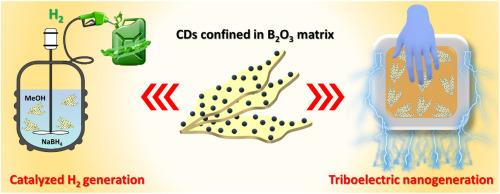Biomass-derived carbon dots embedded in B2O3 matrix with high proton density: A role as metal-free catalyst and hydrogel fillers for renewable energy applications
IF 8.3
2区 工程技术
Q1 CHEMISTRY, PHYSICAL
引用次数: 0
Abstract
Biomass-derived carbon dots (CDs) are emerging as promising candidates for fluorescent sensing and energy applications due to their tunable optical properties and environmental sustainability. However, their practical utility in renewable energy systems is hindered by low proton density, insufficient Lewis acid sites, poor ionic conductivity, and a strong tendency to aggregate. Herein, CDs from coffee waste are systematically embedded in a boron oxide (B2O3) matrix using boric acid (BA) as boron source via hydrothermal method. The resulting composite (BA1CD) serves as a metal-free catalyst for hydrogen generation through sodium borohydride (NaBH4) methanolysis. The B2O3 matrix induces Lewis acid sites in BA1CD that activate methanol for the reaction. Consequently, BA1CD exhibits remarkable catalytic activity for hydrogen generation, with a high hydrogen generation rate (139 L H2 g−1 min−1) and low activation energy (26.2 kJ/mol). Furthermore, BA1CD is incorporated as functional filler into polyacrylamide (PAM) hydrogel for triboelectric nanogenerator (TENG). Interestingly, B2O3 matrix promotes uniform dispersion of the CDs and prevents the aggregation of CD in the PAM hydrogel. Therefore, BA1CD/PAM hydrogel demonstrates superior TENG performance with high output voltage (37.8 V) and current density (6.6 mA/m2), successfully powering various low-voltage everyday devices. This study provides a sustainable and multifunctional approach for biomass valorization toward advanced energy harvesting and storage technologies.

生物质衍生碳点嵌入高质子密度B2O3基质:可再生能源应用中无金属催化剂和水凝胶填料的作用
由于其可调谐的光学特性和环境可持续性,生物质衍生的碳点(CDs)正在成为荧光传感和能源应用的有前途的候选者。然而,它们在可再生能源系统中的实际应用受到质子密度低、刘易斯酸位不足、离子电导率差和聚集倾向强的阻碍。本研究以硼酸(BA)为硼源,通过水热法将咖啡废渣中的CDs系统地嵌入到氧化硼(B2O3)基质中。得到的复合材料(BA1CD)作为无金属催化剂,通过硼氢化钠(NaBH4)甲醇分解制氢。B2O3基质在BA1CD中诱导Lewis酸位点,激活甲醇进行反应。因此,BA1CD具有较高的产氢速率(139 L H2 g−1 min−1)和较低的活化能(26.2 kJ/mol),具有显著的产氢活性。此外,还将BA1CD作为功能性填料掺入摩擦电纳米发电机(TENG)用聚丙烯酰胺(PAM)水凝胶中。有趣的是,B2O3基质促进了CD的均匀分散,并阻止了CD在PAM水凝胶中的聚集。因此,BA1CD/PAM水凝胶具有优异的TENG性能,具有高输出电压(37.8 V)和高电流密度(6.6 mA/m2),成功地为各种低压日常设备供电。该研究为生物质能向先进的能量收集和储存技术发展提供了一种可持续和多功能的途径。
本文章由计算机程序翻译,如有差异,请以英文原文为准。
求助全文
约1分钟内获得全文
求助全文
来源期刊

International Journal of Hydrogen Energy
工程技术-环境科学
CiteScore
13.50
自引率
25.00%
发文量
3502
审稿时长
60 days
期刊介绍:
The objective of the International Journal of Hydrogen Energy is to facilitate the exchange of new ideas, technological advancements, and research findings in the field of Hydrogen Energy among scientists and engineers worldwide. This journal showcases original research, both analytical and experimental, covering various aspects of Hydrogen Energy. These include production, storage, transmission, utilization, enabling technologies, environmental impact, economic considerations, and global perspectives on hydrogen and its carriers such as NH3, CH4, alcohols, etc.
The utilization aspect encompasses various methods such as thermochemical (combustion), photochemical, electrochemical (fuel cells), and nuclear conversion of hydrogen, hydrogen isotopes, and hydrogen carriers into thermal, mechanical, and electrical energies. The applications of these energies can be found in transportation (including aerospace), industrial, commercial, and residential sectors.
 求助内容:
求助内容: 应助结果提醒方式:
应助结果提醒方式:


